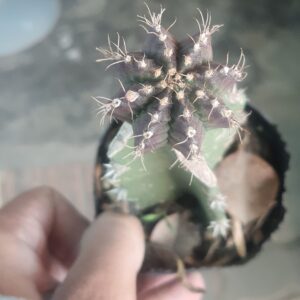A bright, glittering light. A Combination of Beauty and Strength: The Grafted Cactus Mammillaria sp.
Any species or hybrid of the Mammillaria genus that has been grafted onto a robust cactus rootstock, such as Hylocereus, Trichocereus, or Myrtillocactus geometrizans, is referred to as a Mammillaria sp. Grafted Cactus. Particularly for species that may otherwise have difficulty with poor soil, pests, or weak roots, grafting improves the growth, health, and lifespan of cacti.
Mammillaria cultivars are very well-liked because they mix the attractive beauty of Mammillaria species—known for their thick spines, woolly areoles, and delicate flowers—with the vigorous growth potential of their rootstock. These plants are well-liked in collections, particularly in areas where the indigenous Mammillaria species may have trouble establishing on their own roots.
Overview of Botany
Mammillaria is the genus name, and it is grafted onto a variety of cactus species.
Family: Cactaceae
Origin: Although indigenous to Mexico, Central America, and the Southwest United States, native Mammillarias are grown in horticulture through grafting.
Growth Habit: Short cylindrical to globular, dense spination, frequently clustered
Size:
Scion (top cactus): Often between 5 and 15 cm (2 and 6 inches) in height, depending on the kind.
Combined height with rootstock: 10–30 cm (4–12 inches)
Hardiness Zones for the USDA: Generally hardy in zones 9–11, depending on the rootstock
Flowers are everywhere.
Time of Bloom: Late spring through summer
Look:
tiny, funnel-shaped blooms
The color palette varies depending on the species of Mammillaria, ranging from pink, red, magenta, white, to yellow.
The apex is surrounded by a wreath of flowers, which enhances its beauty.
Because of the strength given by the rootstock, grafted Mammillarias have a propensity to bloom more easily and often.
Requirements for Lighting
Inside:
Requires filtered sunlight or bright, indirect illumination
Location adjacent to windows that face south or east
Add grow lights if there isn’t enough natural light
Outside:
Likes full sun more than partial shade
In extremely hot regions, shield against intense midday sun to avoid sunburn.
Sufficient light promotes strong spine colour, dense growth, and bloom.
Humidity and temperature
Temperature:
Ideal range: 20–30°C (68–86°F)
Frost-sensitive; keep at a temperature of 5°C (41°F) or above.
Cold tolerance is affected by the rootstock; some tolerate somewhat colder temperatures if maintained dry.
Humidity:
Prefers moderate to low humidity
To avoid rot, particularly at the graft junction, make sure the air circulation is adequate.
💧 Watering Schedule
Season of Growth (Spring to Early Fall):
Water when the top 1–2 inches of soil are dry
Usually, every 10–14 days, taking the environment and container size into account.
Completely water, but make sure the extra water drains out.
Winter Dormancy:
Water less frequently, perhaps once a month or less.
In colder months, keep it as dry as possible.
The main risk is overwatering, particularly close to the graft junction, where rot can take hold.
Requirements for the Soil
Type:
Requires a cactus mix that drains well
Suggested mixture:
50% cactus and succulent mix
25% rough sand
25% pumice or perlite
pH: Neutral to mildly acidic
To avoid rotting of the scion and rootstock, the soil must drain well.
🌾 Applying Fertilizer
At the Time of Growth:
Use a balanced, diluted cactus fertilizer (5-10-10 or 10-10-10) once a month.
In the winter, refrain from fertilizing.
Avoid over-fertilization, which can result in too much growth that is also weak.
Pruning and upkeep
Pruning:
Get rid of any dead blooms, injured tissue, or unhealthy pups.
It can need pruning if the rootstock begins to overtake or outgrow the scion.
Pest management:
Look for:
Mealybugs
insects that scale
arachnid mites
Treat with neem oil, insecticidal soap, or alcohol wipes
🌿 Reproduction
Re-Grafting:
The Mammillaria may be grafted again onto a new rootstock if the graft fails or gets weak.
To graft:
Cut both the scion and the stock cleanly.
Put them close together.
Use rubber bands to keep them in place for seven to ten days, until they fuse together.
Offsets:
If the Mammillaria scion produces pups, they can be rooted if the species allows, or grafted onto new stock.
Common problems
Graft Union rot: Caused by excessive irrigation or insufficient ventilation
Mealybugs and mites are pests that can harm the rootstock and scion.
Sunburn: Excessive exposure to direct sunshine without acclimatization
Most problems can be avoided with adequate care, especially by making sure the soil is dry, there is plenty of light, and there is good airflow.
🎍 Ornamental Use
Ideal for:
collections of cacti
Ornamental pots for the interior
Plants that serve as focal points in gardens with succulents
Mammillaria grafts are highly valued in exhibits because they frequently have distinctive looks and flower more easily.
Conclusion
Compared to some fragile species on their own roots, a grafted cactus of the genus Mammillaria is not only aesthetically beautiful but also more robust and manageable. This grafted beauty can flourish and blossom for years with plenty of sunshine, careful irrigation, well-drained soil, and sporadic feeding.”

Mammillaria Sp Grafted
Original price was: ₨2,000.00.₨1,499.00Current price is: ₨1,499.00.
“A Mammillaria cactus species that has been grafted onto a hardy rootstock, such as *Hylocereus* or *Myrtillocactus*, is known as a **Mammillaria sp. Grafted**. The plant’s growth, hardiness, and frequently its vibrant color and early flowering are improved through grafting.
Small, rounded, or cylindrical cacti belonging to the genus Mammillaria are distinguished by their thick spines, tubercles, and crown-like rings of tiny, vibrant blooms, usually in pink, red, or yellow. Mammillarias that have been grafted are simpler to maintain since the rootstock offers superior nutrient absorption and rot resistance.
They flourish in bright, indirect sunlight, prefer well-drained soil, and need very little water, especially when dormant. Collectors favor the distinct look and improved development of the **Mammillaria sp. Grafted**, as well as its use as an ornamental indoor or garden plant.”




Reviews
There are no reviews yet.